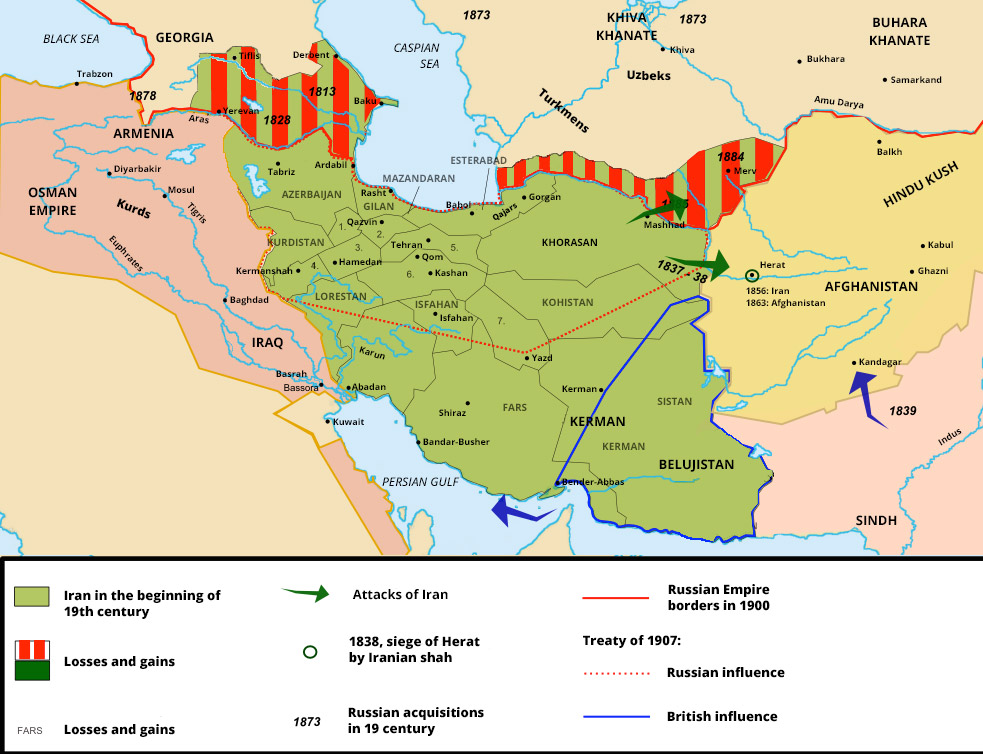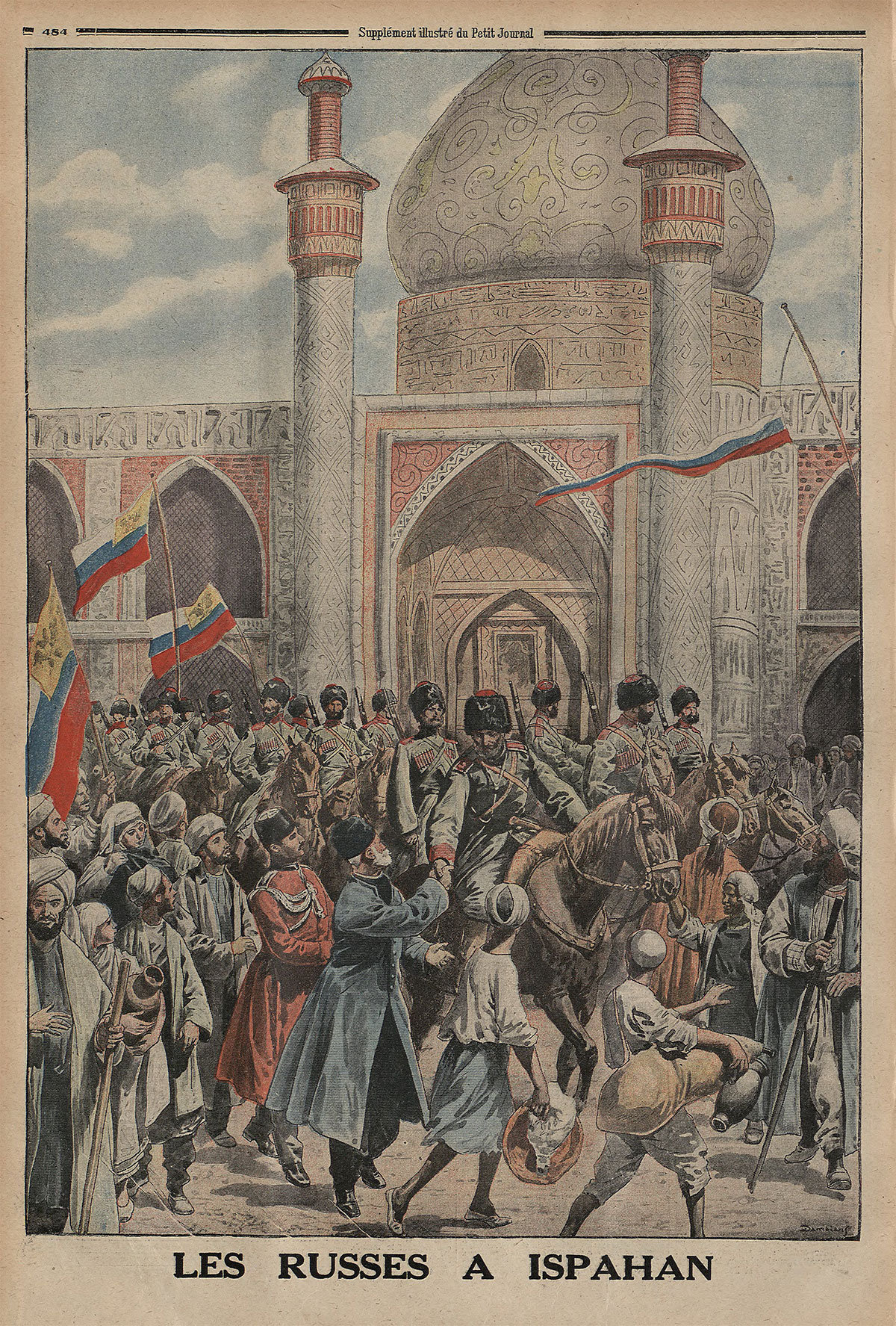Isfahan
In terms of strategic planning, Persia has always been a very interesting country for Russia and England.
The reader already knows that in 1941 the USSR and Great Britain occupied Iran, overthrew the local Shah, and opened a corridor through which a quarter of all lend-lease supplies were transported. But that was during World War II. What happened during the First World War?
In the First World War, more precisely before its beginning, the Russian and British empires divided Persia into three parts. The Russians took control of the northern part of the country, the British took the southern part, and a narrow neutral strip was left in the center.
In principle, the Russian Empire had been expanding towards Central Asia for a long time. The scale of this imperial expansion is difficult to imagine. For example, we are already accustomed to the modern map that includes Azerbaijan, Armenia, and Georgia. Well, Azerbaijan was just a part of Persia until 1813. The eastern part of Georgia, including the capital Tbilisi, was also part of Iran. Armenia remained part of Persia for 15 years longer. Only as a result of the two Russo-Persian wars did these regions become part of the Russian Empire, and later, after its collapse and then the collapse of the USSR, they became separate countries.
During those times, the Russian Empire advanced deep into Persia, almost reaching the center of the country. The border extended in a way that included the city of Isfahan and came close to reaching the city of Yazd.

During the First World War, when Russia, England, and France were opposed to Germany and Turkey, the Germans and Turks launched an offensive in northern Iran and attempted to incite a popular uprising in the country.
To defend the reclaimed territories, the Russian Empire sent Cossack troops led by General Baratov, who alternately surrendered and recaptured Iranian cities until 1918. After two revolutions, Russia not only lost Iran but almost Pskov as well. All positions in Iran had to be relinquished, and the Cossacks were withdrawn back to the Caucasus.
Afterwards, the idea of conquering Persia continued to stir the minds of Stalin, Hitler, and many others for a long time. It only subsided by the middle of the century.
And I am telling you all this just to explain the French painting of 1916: “Russians in Isfahan.”

⁂
Describing Isfahan is very simple.
In the center of the city, there is a gigantic square called Naqsh-e Jahan, which with its size and mystical minarets bears a striking resemblance to one of the levels in “Serious Sam 2”.

The square was built in the early 1600s when Isfahan became the capital of the new Safavid Empire, established on the site of Persia. It was during that time that the new mayor in the city’s center demolished the tents selling shawarma and instead constructed this square, which translates to “Design of the World.”

The weather in Iran in May ranges from 15 to 25 degrees Celsius, often accompanied by rain. On one hand, this is good because Iran is not a desert like Saudi Arabia. On the other hand, without the sun, all these mosques appear somewhat grayish, especially when adorned with construction scaffolding.

In the absence of both sun and rain, Iranian mosques turn into black voids. There is no wind, and the entire atmosphere stands still. There is also no light. Everything is engulfed in uniform gray paint. Windows and entry arches appear as pathways to nowhere, as if all the air has been sucked out of the buildings.

Before a thunderstorm with rain, the atmosphere seems to fill with grayness, and the city is engulfed in yellow light, resembling the mouth of a volcano. The arches begin to look like chasms in space.

The inner courtyards of the square are empty of people and devoid of air—only lifeless, stone, alien structures.

But when the rain starts, it’s a different story. Look at all that greenery.



The owner of the dishware shop reads a newspaper after the rain.

Gradually, the most expensive shops that open directly onto the square are revealed.

Regarding the domestic market — it was never closed, rain doesn’t hinder it, trade here goes on from early morning until night.

Along the perimeter of the square, there is a massive bazaar where carpets, teapots, samovars, plates, lamps, mirrors, and countless souvenirs are sold in unimaginable quantities. Unlike Tehran’s Grand Bazaar, the market in Isfahan is a true Persian bazaar.

They sell a wide variety of miscellaneous items in excessive quantities, just like everywhere in the East. The showcases are modestly lit, but the shiny goods inside glow with either gold or blue, depending on what is being sold.

Of course, samovars glisten with gold. They are particularly popular in Iran, presumably influenced after the war with the Russian Empire.

The smaller teapots and utensils shine with pure copper.

The stalls with clocks and small boxes have a greenish hue.

The truly extraordinary items such as lamps, pitchers, decorative candy dishes, and sugar bowls emit a malachite shade.

The most popular plates in Iran, made of copper, shine with blue and turquoise. Yes, almost all the dishes in the bazaar are copper. These patterns and reflections are not made on glass, but hammered and chiseled, embossed in copper, and covered with paint.

The nearby stalls with blue plates and something golden are the most luxurious spots in the entire bazaar.


Additionally, the market rows are adorned with neon signs.
Such endless rows encircle the square along its entire perimeter, forming a labyrinth around it.

The perimeter of Isfahan’s square, which includes only the main portion of the bazaar, stretches for 1.5 kilometers. If we add up all the adjacent rows and branches, the length of the market easily reaches three to four kilometers!

The bazaar is popular among everyone at any time of the day. Iranians themselves, both men and women, mainly purchase jewelry and household items.

A separate category, as always, is spices — they are sold in kilograms and bags on any Eastern market.

Carpets have slower sales. A large and expensive Persian carpet cannot be easily carried away by a tourist, so people mainly buy small rugs, as well as embroidered throws, scarves, and tablecloths.

Seemingly, no one buys the endless junk.


As the reader has already noticed, there is no division by goods in the Isfahan bazaar. Everything is sold mixed together. In addition, Iranians hardly bargain. This is the main difference between the Persian bazaar and the Arab one.
The magic of Persia!

Naqsh-e Jahan Square is the most touristy, European-like place in Isfahan, and perhaps the only one. If the weather disappointed during the day, it’s better to come here at night. The domes with intricate patterns shine with a blue color. The city transforms into a Disney-like backdrop.


An enormous number of details in the mosaic.

The market shines with gold at night.

As for the rest of the city, it doesn’t exist for tourists. The working streets of Isfahan are no different from those in Tehran.

While walking to the bazaar, you can come across several charming places.

The city authorities have artistically cleaned up several streets so that tourists can comfortably reach the square.

Well, they installed a couple of new doors in the entrances.

If you deviate from the tourist path, Isfahan is quite unattractive. There are dilapidated clay houses, broken windows, and crumbling sidewalks.

The outskirts of the bazaar resemble catacombs.

The country is still poor. It is evident that under the weight of time, the few things that were good during the Shah’s era are deteriorating and falling apart.

Non-touristic streets are particularly grim before the rain.
The sky is covered with leaden clouds. There is no daylight during the day—it feels like evening. Crooked minarets rise above dilapidated houses. The muezzin chants his eternal “Allahu Akbar.” It feels like being transported to somewhere like Mosul in Iraq or the capital of ISIS — Raqqa.

But everything is fine. It’s a peaceful and beautiful Iran, just a bit dirty.

And it’s time for us to get out from the bazaars of Isfahan and visit Yazd — a city that has long been at war with Isfahan. The war for the title of the most beautiful city in Persia.


